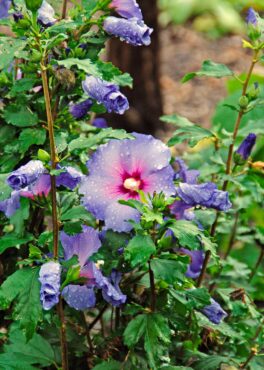
Create a colorful year-round garden filled with flowers, greenery, colorful fruit, fall color, winter interest and a few surprises. Consider seasonal interest when planning a new garden or landscape. Adding a few key plants to existing gardens can help boost your landscape’s seasonal appeal.
Include a variety of plants with multiple seasons of interest as well as bird and pollinator appeal. You will look forward to the change of seasons as your landscape transforms throughout the year.
Use trees and shrubs to provide the framework and longevity in your landscape. Serviceberries, crabapples, dogwoods and many others have flowers, fruit, pollinator and bird appeal and add winter interest with their bark or form. Look for those with colorful exfoliating bark like paperbark maple, heptacodium and river birch for a beautiful statement in the winter garden.
Include a few summer blooming shrubs like St. John’s wort, buttonbush, panicle hydrangeas and Rose of Sharon. They add an unexpected fresh look to your summer landscape.
Perennials combine nicely with trees, shrubs and annuals, adding seasons of color and texture. Include those that also attract songbirds, bees and butterflies by creating a beautiful habitat. Blue star (Amsonia), Siberian iris, sedum, Rudbeckia, coneflower and grasses are just a few that can brighten any garden with several seasons of color and provide homes for beneficial insects and food for the birds.
End the season with fall bloomers like goldenrod, asters and hardy mums. These provide food for late-season pollinators. Leave healthy plants stand, providing homes for many beneficial insects, winter interest in the garden and food for the songbirds.
Use annuals to fill any voids and add season-long color and yearly changes in the landscape. Containers on steps, decks and patios help bring the garden to your front and back door.
Include spring-flowering bulbs like tulips, daffodils and hyacinths planted in fall for a colorful welcome to spring. These and many of the earliest bloomers like winter aconites, grape hyacinths and crocus provide needed nectar for early-season pollinators.
Evergreens are always a welcome addition to any landscape. They provide shelter for the birds and year-round greenery. Find new and interesting ways to include them in your landscape.
Use taller evergreens for screening bad views, buffering traffic and other noises or creating privacy. Use evergreens with interesting form and texture to create a focal point in a garden bed or landscape. Combine them with perennials and flowering shrubs for added seasonal interest.
Then keep your landscape looking its best by protecting key plants from hungry critters like deer, rabbits and voles. Skip the fencing and scare tactics by applying a rain-resistant, organic repellent like Plantskydd at planting. You will need fewer applications and the odor-based repellent sends animals dining elsewhere before taking a bite out of your plants. Apply repellent before animals start feeding and follow the label directions for best results.
Continue to gather ideas with visits to public gardens and partaking in garden tours. Be sure to take notes and pictures that you can reference later. Creating a year-round landscape is an ongoing process that is part of the fun and adventure of gardening.























Comments